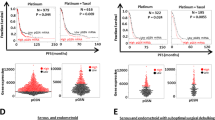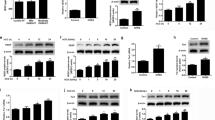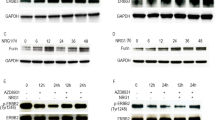Abstract
Granulin-epithelin precursor (GEP/progranulin) is an autocrine growth factor for ovarian cancer. We examined the production and function of GEP and report that: (1) GEP production is regulated by endothelin (ET-1), lysophosphatidic acid (LPA), and cAMP; (2) cAMP signals GEP production through exchange protein activated by cAMP (EPAC); (3) ET-1 and cAMP/EPAC induce GEP through ERK1/2; and (4) neutralization of GEP results in apoptosis. Exposure of HEY-A8 and OVCAR3 ovarian cancer cells to LPA and ET-1 yielded GEP production and secretion in a dose- and time-dependent fashion; neither stimulated significant concentrations of cAMP directly. Stimulation of cAMP production with pertussis and cholera toxin, or forskolin induced GEP in a PKA-independent fashion. EPAC, an intracellular cAMP receptor, is activated specifically by the cAMP analog, 8-CPT-2′-O-Me-cAMP (8-CPT); 8-CPT treatment stimulated GEP production and secretion. The MEK inhibitor, U0126, abrogated GEP production in response to ET-1 and 8-CPT, confirming involvement of MAPK. A partial inhibition of basal and stimulated GEP production was observed when cells were treated with a internal calcium chelator, BAPTA. Neutralizing anti-GEP antibody reversed basal as well as LPA, ET-1 and 8-CPT-induced ovarian cancer cell growth and induced apoptosis as demonstrated by caspase-3 and PARP cleavage, DNA fragmentation, and nuclear condensation. These results indicate that GEP is a growth and survival factor for ovarian cancer, induced by LPA and ET-1 and cAMP/EPAC through ERK1/2.
This is a preview of subscription content, access via your institution
Access options
Subscribe to this journal
Receive 50 print issues and online access
$259.00 per year
only $5.18 per issue
Buy this article
- Purchase on Springer Link
- Instant access to full article PDF
Prices may be subject to local taxes which are calculated during checkout








Similar content being viewed by others
References
Alper O, Hacker NF and Cho-Chung YS . (1999). Oncogene, 18, 4999–5004.
Amsterdam A, Gold RS, Hosokawa K, Yoshida Y, Sasson R, Jung Y and Kotsuji F . (1999). Trends Endocrinol. Metab., 10, 255–262.
Bagnato A, Salani D, Di Castro V, Wu-Wong JR, Tecce R, Nicotra MR, Venuti A and Natali PG . (1999). Cancer Res., 59, 720–727.
Bagnato A, Tecce R, Di Castro V and Catt KJ . (1997). Cancer Res., 57, 1306–1311.
Bagnato A, Tecce R, Moretti C, Di Castro V, Spergel D and Catt KJ . (1995). Clin. Cancer Res., 1, 1059–1066.
Bateman A, Belcourt D, Bennett H, Lazure C and Solomon S . (1990). Biochem. Biophys. Res. Commun., 173, 1161–1168.
Bateman A and Bennett HP . (1998). J. Endocrinol., 158, 145–151.
Bos JL . (2003). Nat. Rev. Mol. Cell Biol., 4, 733–738.
Cho YS, Kim MK, Cheadle C, Neary C, Becker KG and Cho-Chung YS . (2001). Proc. Natl. Acad. Sci. USA, 98, 9819–9823.
Daub H, Weiss FU, Wallasch C and Ullrich A . (1996). Nature, 379, 557–560.
Davidson B, Alejandro E, Florenes VA, Goderstad JM, Risberg B, Kristensen GB, Trope CG and Kohn EC . (2004). Cancer, 100, 2139–2147.
Del Bufalo D, Di Castro V, Biroccio A, Salani D, Rosano L, Spinella F and Bagnato A . (2002a). Clin. Sci. (London), 103 (Suppl 48), 302S–305S.
Del Bufalo D, Di Castro V, Biroccio A, Varmi M, Salani D, Rosano L, Trisciuoglio D, Spinella F and Bagnato A . (2002b). Mol. Pharmacol., 61, 524–532.
Enserink JM, Christensen AE, de Rooij J, van Triest M, Schwede F, Genieser HG, Doskeland SO, Blank JL and Bos JL . (2002). Nat. Cell Biol., 4, 901–906.
Fang X, Schummer M, Mao M, Yu S, Tabassam FH, Swaby R, Hasegawa Y, Tanyi JL, LaPushin R, Eder A, Jaffe R, Erickson J and Mills GB . (2002). Biochim. Biophys. Acta., 1582, 257–264.
Goetzl EJ, Dolezalova H, Kong Y and Zeng L . (1999). Cancer Res., 59, 4732–4737.
Guirland C, Buck KB, Gibney JA, DiCicco-Bloom E and Zheng JQ . (2003). J. Neurosci., 23, 2274–2283.
He Z and Bateman A . (2003). J. Mol. Med., 81, 600–612.
He Z, Ong CH, Halper J and Bateman A . (2003). Nat. Med., 9, 225–229.
Herrlich A, Daub H, Knebel A, Herrlich P, Ullrich A, Schultz G and Gudermann T . (1998). Proc. Natl. Acad. Sci. USA, 95, 8985–8990.
Jemal A, Tiwari RC, Murray T, Ghafoor A, Samuels A, Ward E, Feuer EJ and Thun MJ . (2004). CA. Cancer J. Clin., 54, 8–29.
Jones MB, Michener CM, Blanchette JO, Kuznetsov VA, Raffeld M, Serrero G, Emmert-Buck MR, Petricoin EF, Krizman DB, Liotta LA and Kohn EC . (2003). Clin. Cancer Res., 9, 44–51.
Kang G, Joseph JW, Chepurny OG, Monaco M, Wheeler MB, Bos JL, Schwede F, Genieser HG and Holz GG . (2003). J. Biol. Chem., 278, 8279–8285.
Keiper M, Stope MB, Szatkowski D, Bohm A, Tysack K, Vom Dorp F, Saur O, Oude Weernink PA, Evellin S, Jakobs KH and Schmidt M . (2004). J. Biol. Chem., 279, 46497–46508.
Kim S, Jee K, Kim D, Koh H and Chung J . (2001). J. Biol. Chem., 276, 12864–12870.
Kopperud R, Krakstad C, Selheim F and Doskeland SO . (2003). FEBS Lett., 546, 121–126.
Liotta LA, Espina V, Mehta AI, Calvert V, Rosenblatt K, Geho D, Munson PJ, Young L, Wulfkuhle J and Petricoin E Fr . (2003). Cancer Cell, 3, 317–325.
Lu R and Serrero G . (1999). Biochem. Biophys. Res. Commun., 256, 204–207.
Lu R and Serrero G . (2000). Proc. Natl. Acad. Sci. USA, 97, 3993–3998.
Lu R and Serrero G . (2001). Proc. Natl. Acad. Sci. USA, 98, 142–147.
McDaid HM, Cairns MT, Atkinson RJ, McAleer S, Harkin DP, Gilmore P and Johnston PG . (1999). Br. J. Cancer, 79, 933–939.
Mei FC, Quai J, Tsygankova OM, Meinkoth JL, Quilliam LA and Cheng X . (2002). J. Biol. Chem., 277, 11497–11504.
Mills GB and Moolenaar WH . (2003). Nat. Rev. Cancer, 3, 582–591.
Nicosia SV, Bai W, Cheng JQ, Coppola D and Kruk PA . (2003). Hematol. Oncol. Clin. North Am., 17, 927–943.
Rangarajan S, Enserink JM, Kuiperij HB, de Rooij J, Price LS, Schwede F and Bos JL . (2003). J. Cell. Biol., 160, 487–493.
Rosano L, Spinella F, Salani D, Di Castro V, Venuti A, Nicotra MR, Natali PG and Bagnato A . (2003). Cancer Res., 63, 2447–2453.
Rosano L, Varmi M, Salani D, Di Castro V, Spinella F, Natali PG and Bagnato A . (2001). Cancer Res., 61, 8340–8346.
Salani D, Di Castro V, Nicotra MR, Rosano L, Tecce R, Venuti A, Natali PG and Bagnato A . (2000). Am. J. Pathol., 157, 1537–1547.
Salani D, Rosano L, Di Castro V, Spinella F, Venuti A, Padley RJ, Nicotra MR, Natali PG and Bagnato A . (2002). Clin. Sci. (London), 103 (Suppl 48), 318S–321S.
Shabb JB and Corbin JC . (1990). J. Biol. Chem., 265, 5267–5272.
Vacca F, Bagnato A, Catt KJ and Tecce R . (2000). Cancer Res., 60, 5310–5317.
Xu Y, Fang XJ, Casey G and Mills GB . (1995). Biochem. J., 309 (Part 3), 933–940.
Zanassi P, Paolillo M, Feliciello A, Avvedimento EV, Gallo V and Schinelli S . (2001). J. Biol. Chem., 276, 11487–11495.
Zanocco-Marani T, Bateman A, Romano G, Valentinis B, He ZH and Baserga R . (1999). Cancer Res., 59, 5331–5340.
Zhang H and Serrero G . (1998). Proc. Natl. Acad. Sci. USA, 95, 14202–14207.
Zhou J, Gao G, Crabb JW and Serrero G . (1993). J. Biol. Chem., 268, 10863–10869.
Zhu J, Nathan C, Jin W, Sim D, Ashcroft GS, Wahl SM, Lacomis L, Erdjument-Bromage H, Tempst P, Wright CD and Ding A . (2002). Cell, 111, 867–878.
Acknowledgements
We thank L Liotta for helpful discussions and V Virador, B Taylor, S Garfield, and S Wincovitch for technical support and guidance.
Author information
Authors and Affiliations
Corresponding author
Rights and permissions
About this article
Cite this article
Kamrava, M., Simpkins, F., Alejandro, E. et al. Lysophosphatidic acid and endothelin-induced proliferation of ovarian cancer cell lines is mitigated by neutralization of granulin–epithelin precursor (GEP), a prosurvival factor for ovarian cancer. Oncogene 24, 7084–7093 (2005). https://doi.org/10.1038/sj.onc.1208857
Received:
Revised:
Accepted:
Published:
Issue Date:
DOI: https://doi.org/10.1038/sj.onc.1208857
Keywords
This article is cited by
-
Progranulin promoted the proliferation, metastasis, and suppressed apoptosis via JAK2-STAT3/4 signaling pathway in papillary thyroid carcinoma
Cancer Cell International (2023)
-
Prognostic significance of serum progranulin level in de novo adult acute lymphoblastic leukemia patients
Clinical and Experimental Medicine (2020)
-
Inhibition of PI3K/AKT/mTOR and MAPK signaling pathways decreases progranulin expression in ovarian clear cell carcinoma (OCCC) cell line: a potential biomarker for therapy response to signaling pathway inhibitors
Medical Oncology (2020)
-
Insights into exchange factor directly activated by cAMP (EPAC) as potential target for cancer treatment
Molecular and Cellular Biochemistry (2018)
-
Progranulin and its biological effects in cancer
Medical Oncology (2017)



